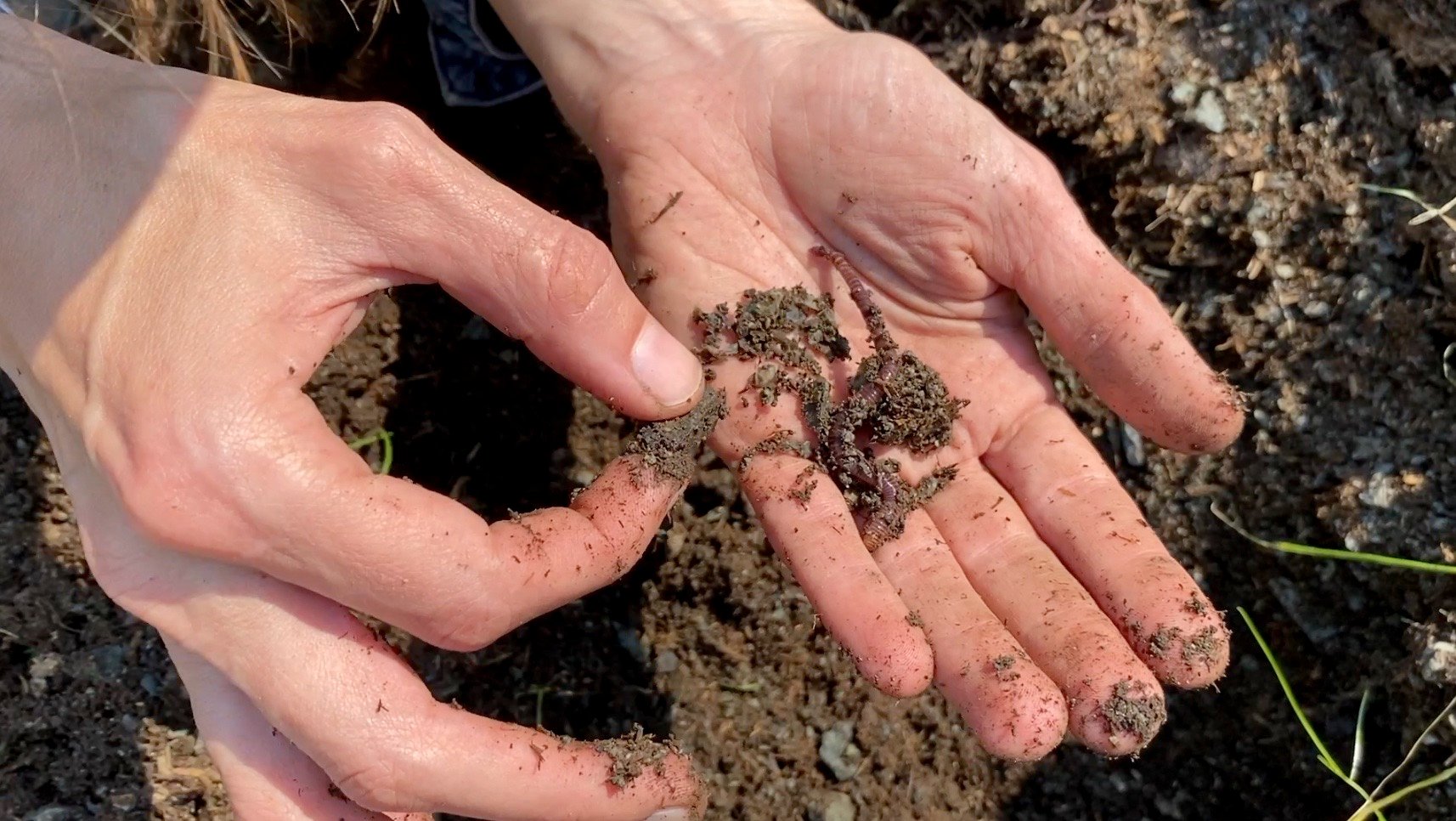I’m sad to say, I did not compost my horse manure for 5 years because it just seemed too complicated to me. I had tried composting at home, read all about it, got a special composting unit sponsored by my city program, and… total fail. The whole “getting the right ratio/layers of brown and green” not to mention turning, aerating, moisture levels etc… aaaarghhh! Too complicated, too much work, and if I couldn’t even compost food scraps, how was I going to succeed with 500 lbs of manure per day?

So I paid for a huge 20’x8’x4′ manure bin that I would fill every month, and then pay to have it carted off to a composting facility and returned to me empty. Horrendously expensive and time consuming – you have to keep ‘shoveling up’ the manure as you dump it in the bin. Unless you have a ramp down to a sunken spot for the bin (so you can dump from the sides into a sunken bin), you have to keep shoveling the manure, after dumping, up to the rim, so you get your money’s worth from the $300 haul/compost fee each month. Then you also have to pay for monthly bin rental.
When I googled how to compost horse manure, or talked to people who were doing it, I heard the same advice about layering the manure with dry shavings, straw, or leaves. And that you also had to either turn the pile regularly (I know a woman who had 2 horses and would hand-turn her manure compost with a shovel!), or, use some kind of aeration method – like sinking vertical PVC pipes drilled with holes into your pile. Again, having already failed at composting a small garbage can worth of food scraps, I had no faith in being able to successfully compost tons of manure.
Until one day, my husband Ian came home from a trip to Mayne Island, where he had toured a lavender farm. The woman who owned the lavender farm, also had horses. She composted their manure so she could add rich soil yearly to her lavender fields. Ian told me that all she did was pile up the manure, put a tarp over it at the end of the summer, and leave it for a year. What???! Could it possibly be THAT EASY??
So I tested it. I had a tractor empty my manure pit and pile it over to the side, where I fenced it off using arena panels. I let the manure pile get rained on a couple of times in the Fall, and then I put tarps over it; secured with pallets to keep the wind from blowing the tarps off. THAT’S IT. That’s all I did. 10 months later, I took the tarps off and voila! Perfectly composted manure/soil, teeming with healthy earthworms. I could.not.believe.it. See for yourself…
If you live somewhere you get a good cold winter, with lots of snow and a good hot summer – you don’t need to compost manure because nature does it for you! I had horses in Alberta, Canada for a decade and my manure was already broken down into soil by the time summer rolled in. In a rainforest climate, it doesn’t get cold, or hot enough to kill the worms/parasites in manure – so you need to use the heat of composting to do that job for you.
Likewise, if you’re in Arizona or SoCal, you can spread your manure out or leave it in the summer sun and it will be good to go – no worms after 3 weeks and poop dehydrated into tiny grass fibers. But, in those climates, if you wanted to turn your manure into soil, you would likely have to pile it, tarp it and keep it watered regularly to help the process by keeping it moist. However, it may also compost much faster with the tarp helping retain moisture, while increasing temperature, maybe you could have composted soil in only 3-4 months – test it and see!
If you’ve tried this – or have another super easy method – in hotter, drier climates, I’d love to hear all about it…

Jini Patel Thompson is a natural health writer and Lazer Tapping instructor. She began riding at age 2 in Kenya, and got her first horse at age 8 in Alberta, and so continues a life-long journey and love affair with these amazing creatures.








Absolutely splendid!
Thanks!
Beautiful! I love that you figured that out. We have composted in California, during our last year there before moving to Portland in 2000. Before horses! We lived up in Topanga, very dry climate and warm of course. I made a makeshift compost container out of chicken wire and dumped all our kitchen scraps w/some leaves and “dry” items. Up until then I had not seen the results of my own compost (either I kept moving or I didn’t do it right).
I left it like that, not covered (not much rain there!) and after a year, I was shocked to see the most gorgeous soil w/worms had formed! I still remember it to this day, it was such a surprise!!
I was not able to replicate anything like that in Portland in 18 years. We composted in this covered black bin mostly, and mind you, we did pull it open a few times from the bottom and got some very wet wormy soil (which we did use on our raised beds) but it was nothing like the fresh, soft, fluffy soil I remembered from Topanga. There was just not enough light/sun/heat in Portland.
Now, here in eastern WA, we have been composting for almost 4 years, and actually are doing humanure (there is a book by that name). The tiny home we bought and still live in had a compost toilet, which is really not a compost toilet, it is just a place to gather your poop, let’s be honest! So we removed the $1000 toilet, put a bucket with a seat, and use sawdust (we get it for free from a local woodworker) to cover our “deposits” :).
At the beginning, it was gross, then it became normal. Todd is in charge of disposal. We have a whole system… which is described really well in the book. The guys who designed it thought of everything! I honestly did not think we could get compost out of it (we also add kitchen scraps to the buckets before dumping) but we already got 2 huge loads out (about 10 wheelbarrows of compost) which looked great!! We did not use them in the vegetable garden, but around trees we planted.
The horse poop here is another story. Most of it becomes dirt in the summer. We do have a pile, but it has become a big hill, and we just keep adding to it. Not sure we’ll ever do anything with it, especially if we move. Ideally we’d have a tractor and move it a big vegetable garden.A lot of people here just use the horse manure and harrow it over the grass in the spring, and use it as a fertilizer.
If we move to the east coast, I would probably adopt what you just wrote about! Sounds like a great idea!
See that was the same food composting bin I tried here in Vanc! Same climate as Portland, same results. Ian is doing a new experiment now for food here – a large open (no lid) bin made from pallets and he’s thrown all the leaves in there. I told him he will need to talk to the local animals and crows about leaving it open! We’ll see what happens…
THANKS so much for telling us about the humanure system and I really wondered about composting toilets, so that’s good to know too. ALSO found out that if you have your own septic system (series of 4 tanks that result in clean water – thanks to bacteria – that flows back out into your yard), as long as you do NOT put any toilet paper into your system (place it in a covered trash can next to the toilet, like they do in Mexico) you will NEVER have to have your septic tank pumped out! Our friend near the ranch has been doing that for 17 years. We have just had the tank at the ranch pumped clean and now are following the same system – no TP!
For your current location, you do not need to compost the manure – nature does that for you! If you have a good cold winter and then hot summer – all poop is broken down and worms killed. No human help needed! That’s what we have at the ranch and also what I did in Alberta for 10 years. In your climate, your concern is more about *retaining* and improving soil. As per Kesia’s post:
https://listentoyourhorse.com/regenerating-stressed-pasture/
I look forward to hearing what happens and where you go in the next year… 🙂 xoxo
Thanks Jini! In regards to the compost that Ian is testing, we have our current humanure compost covered heavily with straw (bad hay actually, hay that got moldy or whatever) but it is not covered with anything (contained within 4 sides of wood ‘slats’ so the slats can be removed for easy access when compost is done) and in almost 4 years we have not had a problem with any animals in it. Maybe it’s the poop 😃 but we also put kitchen scraps. It is covered by a LOT of hay, and every time we dump, we move the hay to the sides with a pitchfork, and then cover it back up (also keeps it much warmer, up to 140 degrees, 110 degrees in -20 degrees weather!).
I have not heard of a septic with 4 tanks. But I love the idea of not putting TP in the toilet. We’ll try that for sure when we have a septic again.
Correction: the slats are only in the front of the compost bin, the other 3 sides are just wood.
Ah that makes sense and I’m glad you told me that – perfect timing! Ian and I were out there yesterday and he asked me to get another sheet of plywood for the front. BUT your removable slats idea is WAY better – thanks!
Yes, and if you want more info, the Humanure book is online. We followed the exact guidelines for the build out of the bin.
Thanks Vittoria!
I live in a barrier island in North Carolina with humid hot summers and mild winters. I am about to get tow horses and am kind of afraid about the manure. I have only 1.5 acres for the two (mini) horses close to the sound water. The furthest spot away from my house is sometimes a bit swampy. Does anyone have an advice of how to pick the right spot? Also, if I put a tape on at the end of the fall, does that mean it stays uncovered all summer? Wouldn’t that attract tremendous amount of flies?
I am thankful for any advice on how to start this!
Sometimes you just have to experiment to find the best spot on your property. The point of tarping in Fall/Winter/Spring is so that by the time summer comes, you don’t have manure anymore, you have soil 🙂 Then you can use that soil to enrich your pastures, or your garden etc. Or you can leave it and create a hill for your horses – horses love hills!
I am in Kentucky, I also have 1.5 acres and 2 horses I just brought home from a pan expensive boarding stables. Wish me luck as I am about to try the advice the author of this article has published. Just pile it up at the end of my pasture away from the barn and my house, and I will cover it with a tarp before winter. Please let me know how you are doing with your manure!
I pile the manure-no extra anything added, just the manure- into cone shaped heaps and cover them with medium duty tarps in a sunny location on my mini farm.
I turn by hand once with my big shovel and within 4 months I have beautiful soil.
The moisture from “newly dropped” manure plus the steam created by the sun+tarps keeps the manure just damp enough so I haven’t had to add any extra water.
Each time I pick up manure, I uncover the current pile, dump, scrape the pile tight again, re-cover and let nature continue the process.
It’s physical work for sure, but it helps keep me in great shape and the resulting transformed piles are fertilizer Gold!
Thank you for sharing this.
Leslie
Thanks so much for sharing Leslie! Great example of how turning the pile, even once, greatly shortens the composting time. Which city/state/country are you in so we can know your weather situation? eg. Arizona vs. Michigan would be a completely different reality and what worked in one may not work in the other.
Can you tell us what the purpose of the tarps on the manure pile IS? We live in a fairly dry area so I need to know why the tarps. Thanks!
The tarps trap both moisture and heat. The manure has to reach a certain temperature in order to kill worms and to be ideal for composting to take place. Same thing with moisture – a completely dried out pile will not be a good home for the earthworms (which are what facilitate composting AND are magicians when you put them out on your field).
So in your area, you might need to check your tarped pile to see if you need to water it with a hose from time to time… let us know your experiments and what you figure out!
congratulations!!!! (you could have asked me about manure composting years ago when we had the farm in Langley.!) yes just like you discovered on Mayne island- i over-wintered a tarped horse manure pile, very little hog fuel/shaving bedding (i.e. Carbon), included. considered technically “imperfect” compost, as we did not measure or control moisture, nitrogen (hay, grass, plants) , carbon (usually “woody’ type stuff, temperature , aeration. we did use perforated 4” pvc pipes vertically inserted for some aeration, as we didn’t have the space to turn it. burrowing critters like rats and mice helped aeration. Chickens assisted too, they are awemazing manure movers/turners, to get at the prolific worms and insects. All of it got included every year in the organic veg. gardens, and top-spread on the hay fields with the manure spreader. we gave some to city friends too who loved to come for a farm visit… (We did not put in a composting toilet or even an out-house in Langley as it is illegal. well i did convince frank to put an out house eventually, just the year before we had to move. since travelling in South America decades ago i ceased putting TP in toilets. all got burned in the wood stove, never any septic field issues) your new ranch will be a work of HeArt!! xoxoxo
Oh I long for the day we can have chickens… soon! And yes, Kesia and I had discussed the vertical PVC pipes with holes drilled down the sides – but again, that’s still way more complicated (plus I’m not a fan of PVC) than… NOTHING! Well, just a tarp. LOL I remember your outhouse with it’s lovely view – I thought that was such a great idea – as usually people put them in some cloistered spot. I have LOTS of plans for this summer at the ranch… let’s see how far I get! xox
As you know I live in a very hot part of California (lots of days over 100 and even 105-110 degrees) and have been experimenting with different uses of the horse poop! I did do piles of manure in various places away from the horses main area and our house the first few years we lived here and they basically just vanished …with the help of mowing. Then I spread it in big piles layered for a year over about a quarter of an acre out in a flat very degraded part of the land and it is so lush and glorious now! It grows beautifully aith lots a varied species of plants…and the horses will spend a lot of time grazing there! Then after the horses told me to pile it around the oak trees because the ground squirrels were reaking havoc on them (especially the year we didn’t have any dogs) I implemented this approach.. and this year the ones in the main horse area …are piled with lush greenery and any time they poop around them (which is often like a stuf pile) I just add it to the existing dome. The oak trees out in the bigger area are harder to keep the squirrels from burrowing through the poop as I pile it around …but I feel it is still benefiting the trees with all the moisture they are helping retain and the added soil as it breaks down! I will be very interested to see if this benefits them as the years go by? We lost an old growth oak along our driveway in a big wind storm this winter and I was extremely sad! The interesting part was the horses had been pooping consistently next to this tree from the other side of the fence as it was adjacent to there main area. But because of vanity reasons I never piled it around the tree because it’s on the driveway into our house🥲☹️😖 I really regret that! The other interesting thing is since it fell the horses have quit pooping there? So I really feel they were trying to help the tree but I don’t know if it would of made a difference ? But now I will never know🥺.
I am still piling the horse poop on top of the squirrel holes and sometimes it deters them and they don’t reopen them and sometimes they are relentless no matter how much I pile it! I have also used it to layer our new deep garden boxes in the new greenhouse we built! So many uses I adore having this resource!
Glad you figured out how to make it work for you in your climate! I am thinking with the new ranch you won’t need to pick it up as much with the huge area? I love what Vittoria wrote about the humanure not sure I could get my husband on board with this but we do have two septic systems that I would love to attempt this with! Unfortunately Roofus is a bathroom garbage stalker so I am purchasing trash cans with lids!
Love this post so many ways to go with Mother Nature instead of against her!
✌🏼💚🐴
Can you upload any pics of the oaks with their ‘stud piles’ Michelle (or email them to me and I’ll upload). I’d love to see what they look like now. You’ve been doing this for… a year now?
And GREAT news about the degraded bit! How thick did you spread it on that 1/4 acre? And was the poop already composted when you spread it, or still manure?
Okay here are pics of what Michelle is doing with her oak trees… Notice how the poo piles are HUGELY increasing the plant growth around the oaks – which the horses won’t eat down (brilliant!) – thus sequestering water and nutrients.
and another one… the horses are now treating this area like a stud pile and pooping here to further increase nutrients in a wider circumference around the tree.
so glad I found your post. I have new trees planted and heavily mulched and will be adding manure this year. I am going to compost my manure this year vs. spreading it on the field. One thing I found last year was someone added mycorrhiza to the manure and I believe you can do this with a mixture of molasses. I cannot find that so far on the web. Any thoughts on this?
Hi Lisa, if your region naturally grows any kind of fungi then your horse manure will likely already contain some. If you want to cultivate more, take some of your manure and pile it in a semi-shaded spot, uncovered, and see what happens in Spring – if you have the right blend of sun, shade, moisture (mimic where mushrooms normally grow in your area) you will have good mushroom growth on that pile. Then you can add that to your compost pile if you like.
Hi Michelle!
In regards to the humanure, I am happy we did this experiment and we definitely saved a lot of water in the past 3.5 yrs doing this, but I can tell you it’s time consuming and rather disgusting to dispose of, so I am looking forward to moving and having a septic again 🙂 Especially now that Jini told me if I don’t put TP in it, we never have to pump it. To me the whole thing about flushing water, then treating it to clean it is such a waster of energy. But not having to pump, and letting some water trickle into a garden doesn’t sound so bad. Especially that we are planning an east coast move, where it rains all the time 😉
I wanted to mention about the piling up of anything around the trunk. It’s hard to tell how close to the trunk you are piling, but you know covering up the trunk of any tree with soil (or poop) will lead the tree to its demise over time (or possible demise). You probably know, and I could not see from the photo how close you are piling, but you need to leave space and room for the bottom of the trunk to breathe. So, if you were adding poop, you would add it to near the trunk, but not on the trunk. Like, 2-3 inches away from the very bottom of the trunk. I just wanted to make sure you or anyone else knew. It can take years for a tree to die. It just gets smothered. I was part of a neighborhood tree planting project in Portland OR many years ago and took a bunch of classes (and spent summers watering small trees we planted by the school; later they grew to medium size trees, so good to see!) on tree care.
And btw, I lived in CA near gorgeous, old oak trees many years ago and it was an incredible treat. They are stunning and magical!
Our biggest problem with composting in the PNW was the fact that every attempt immediately turned into a lush garden of nettles. Once we learned we could eat nettles, not so bad. But until them rather annoying.
Yes, if you don’t tarp it (and secure the tarp well) you will get nettle city for sure! I also love fresh nettle tea.
Oh nettles!! We finally after many years of living in wet Oregon, figured out when to harvest wild nettles, and went out every year for hours! We ate nettles with everything. Mind you, it was my husband who picked them with leather gloves, then trimmed the stems off (w/leather gloves), and that took hours! But oh, we made nettles pesto, nettles pasta sauce, steamed nettles, nettles w/sauteed garlic, nettles with everything! Now we live in a dry climate and no more nettles.
I just watched your video. Thank you! I did not know it was that easy either. I am in Ontario, Canada (just north of Toronto), hoping the composting will work with this weather too. I will definitely be trying the composting in October this year. Looking forward to more DIY horse farm tips!
Please let us know how it goes!
Will the pile be “sterile” (free of grass and weed seeds) in this period of time?
Mine was definitely not sterile! You can probably Google which temperature it needs to reach and for how long… But I suspect to achieve sterility you may have to actually incinerate the soil.
My friend and I are doing a science fair project on what composts horse manure the fastest. We need to find websites that talk about the same thing we are doing and we need to write an abstract paper about it. Do you have any recommendations on the websites we should use? It’s a little hard to find good websites about this stuff down here in Ohio! (Pretty rare to have multiple horses in New Albany)
Hi Layla, both your comments actually came through, so I deleted one and kept this one as they were saying the same thing 😊
The key thing to remember when trying to find information, is to enter a good search term into your browser, like Google
So I would enter these search terms, and I’m pretty sure it will pull up what you need (each search phrase is a different search. So you are going to search Google three times):
Temperature at which horse manure composts into soil
How does horse manure turn into soil?
Best temperature for composting horse manure
***
That should take you where you need to go. Also, if you read an article on it, also check the references listed for the article, as the reference may contain the actual data that you need.
Hope that helps and let me know how it goes! Don’t be shy if you have any further questions 😊
Hey Jini, we need an adult sponsor for our project. Would you mind if we put your name as our sponsor?
Sure no problem Layla! And please post a link here to the project when you’re done – I (and others) would love to see it 🙂
This really simplifies it!! So nice to hear you actually lived in Alberta too! We just bought a very small, 8.25 acre parcel near Edmonton and have a couple horses and boy are we running into manure issues…. Hauling it out is so expensive to… I have a question regarding what to do in the winter when it’s -30… do you still haul the manure to the pile under tarps and dump it in? Would you save a big winter spot and cover it with a tarp so that you can still access the ground underneath?
My next question would be how does it work with urine soaked shavings? Will that ruin the method?
Thank you for all your help!!
Hi Kiersten,
Well you have a better situation in Edm there since you get a nice cold winter that will kill 95% of the worms in the manure. So if you prefer, you can just leave the manure on your fields and not compost it.
However, if you’re composting manure because you want the soil (not to kill the parasites), again, not much is going to happen during the winter. But your best chance of increasing the temperature is by tarping it.
And yes, you can put your urine-soaked shavings in there, no problem. Urine and feces together contribute to the soil microbiome and are positive inputs. I’m guessing you’re stalling your horses so if they’re generating quite a bit inside their stalls, along with the shavings, then I would dig a manure pit to dump into and then as soon as spring hits, tarp the manure. And dig a second manure pit (or you can pile up into a heap, but that’s WAY more work) to dump your spring/summer manure into.
The absolute easiest way would be to dig 2 manure pits – each one large enough to hold a year’s worth of manure and shavings.
Fill the first pit full of manure and at the end of the year (Spring ideally) tarp it and let it compost down for a year.
Fill the second pit over the course of the next year and then in Spring you tarp that pit.
Your first pit should now be composted soil and you dig it out and use it wherever (some people bag and sell it). This leaves you with an empty manure pit to start dumping into again.
Does that make sense? Keep us posted!